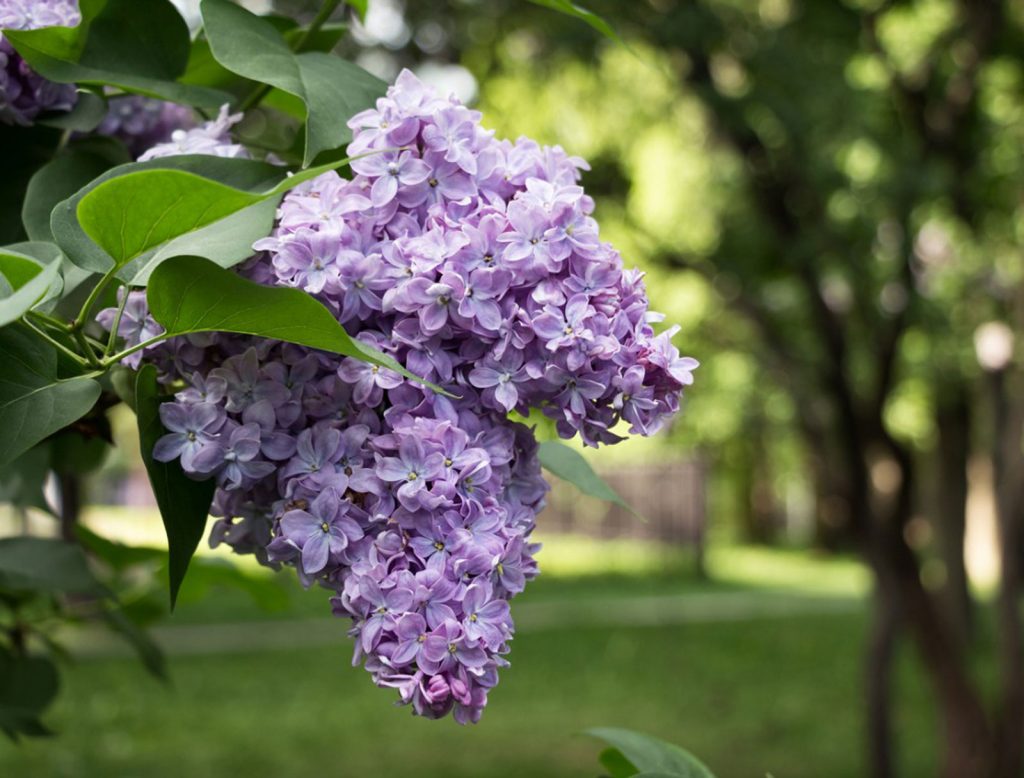
Lilacs announce summer with edible blossoms.
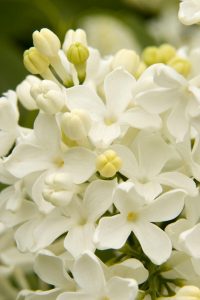
White Lilac are attractive, too.
For more than 60 years I have associated Lilacs with June. In rural Pownal, Maine, I attended four different one-room schools (no running water, outhouses for restrooms, and certainly no telephone phones. But there was a record player and the girls were in charge of playing one song after lunch… if we were good. Mrs. Tryon ruled with an iron fist.) Each school held two grades. The fifth and sixth were at the north end of the town. Directly behind that school was a wall of white Lilacs. Whenever they blossomed we knew school was soon to be over for the summer. The exact day of our release varied year to year. We always started the Tuesday after Labor Day. When we got out in June depended on how many days of school was called off during the winter because of snow or cold temperatures. So our seasonal parole date varied every year. Seeing those Lilac blossom was always a joyful time: The torture would soon be over.

Green Deane, striped shirt, front row, 1962
In the greater Olive family the most common blossom color for Lilac is … lilac. And just in case you’re interested there is a 10-day Lilac Festival in Rochester N.Y. every May (Covid notwithstanding.) Not bad for a plant with European ancestry. At the festival they have over 500 different lilacs on some 1,200 bushes. You can even sample Lilac wine. Where do I sign up? Lilac blossoms are pungent and on the lemony side. In the language of flowers — very much practiced in the 1800’s as a means of conveying information — they were assigned three meanings: The lilac Lilac humility, the purple Lilac emotional love, and the white Lilac youthful innocence. Lilacs don’t grow in Florida. Too hot and humid. Their landscaping substitute is the non-edible Crape Myrtle.
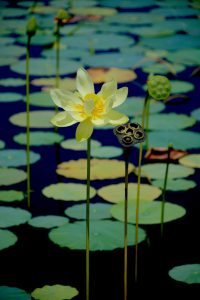
American Lotus, photo by Green Deane
Seen twice this past week in Gainesville and Winter Garden were blossoming American Lotus. The first time I saw a small lake of these blossoms was when an old dry lakebed was deepened and reflooded for a housing development. The next spring suddenly what was for decades a dry lake was full of American Lotus blossoms. This is because the seeds can stay viable some 400 years, or so the experts report. Talk about a survival food! There are multiple edible parts on the American Lotus but I prefer the seeds. I also think when collecting by hand the seeds proved to be the most calories for the least amount of work. The roots are edible but digging them up can be a messy, laborious job. Locally American Lotus are easy to find now: Just look for a lake with large yellow blossoms on long stems. Further north and west they are a favorite sight on rivers such as the Mississippi. To read more about the American Lotus go here.

Classes are held rain or shine.
Foraging classes: It might be a rainy weekend, dress for the potential weather. Classes are in Palm Harbor and Winter Park.
Saturday, June 5th, John Chestnut County Park: 2200 East Lake Road, Palm Harbor, FL 34685. Meet at the trail head of the Peggy Park Nature Walk, pavilion 1 parking lot. 9 a.m. to noon.
Sunday, June 6th, Mead Garden: 1500 S. Denning Dr., Winter Park, FL 32789. 9 a.m. to noon. Meet at the bathrooms. Entrance to the park is on Denning.
Saturday, June 12th, Dreher Park, 1200 Southern Blvd., West Palm Beach, 33405. 9 a.m. to noon. Meet just north of the science center.
Sunday, June 13th, Bayshore Live Oak Park, Bayshore Drive. Port Charlotte. 9 a.m to noon, meet at the parking lot at Ganyard and Bayshore.
Saturday, June 19th, Red Bug Slough Preserve, 5200 Beneva Road, Sarasota, FL, 34233. 9 a.m. to noon.
Sunday, June 20th, Colby-Alderman Park: 1099 Massachusetts Street, Cassadaga. Fla. 32706. 9 a.m. to noon, meet at the bathrooms.
For more information, to prepay or sign up for a class go here.
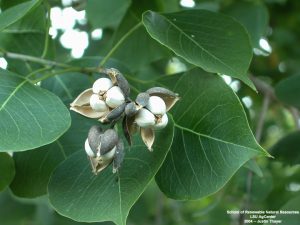
The Chinese Tallow tree is also called the Pop Corn Tree.
During a class this weekend I noticed Chinese Tallow trees are blossoming. The tree poses a challenge. It has an edible fat and a toxic oil. The question is how to easily separate the two. And if “easily” is the wrong descriptor then how can it be made worth a forager’s while?
The tree is an invasive species locally so finding a use for it would help the environment. Also as a source of fat it could literally be a life-saver in time of need because humans cannot survive without fat. In fact one can readily see the fat (also called wax.) It just doesn’t surrender or render easily.
Each seed has a thick coating of highly saturated fat, one reason why the species is also called the popcorn tree because when in fruit it looks covered by popcorn. By all reports the outer coating is edible and has been used to make candles, hence calling it wax. In fact the tree was imported from Asia by Ben Franklin specifically to start a candle-making industry in the South. As a saturated fat the outside is very solid at room temperature. Inside the seed is a liquid oil called stillingia. It is toxic to humans.

Chinese Tallow seed oil, Stillingia, is toxic.
The “wax” is supposed to melt at 104 F. I’ve tried frying the fruit. The outer coating of fat stays solid. I’ve tried boiling. No luck. My readers have tried broiling — the seeds exploded — and micowaving, they got softer but did not melt. In China, reports Merriwether of Houston Edibles, they reportedly softened the fruit in boiling water than scraped it over a fine grater with 0.03-0.5 centimeter holes (Merriwether is a scientist so we get details.) Sounds like a great way to grind down ones fingertips. A third reader has a daughter who used it for a science project. Here’s what they did.
First they bought a hand-operated oil expeller. They cost about $150 on the Internet. They put the entire fruit through the press which also heats the material. Out comes a liquid mass that upon cooling has the solid saturated fat on top. the “wax” and the oil on bottom. The student went on to make candles out of the “wax” and used the oil in a lamp. She won three science fairs and two scholarships. Way to go!
The next question we ask is whether the “wax” and the oil will sufficiently separate so the wax can be used as food? Also is it just as stubborn to melt even after being processed this way? My last question would be how digestible is it? The invasive species certainly has a lot of potential. You can read more about the Chinese Tallow tree here.

Waiting for mom to return.
The fir tree called the Easter Hemlock (Tsuga canadensis) has edible parts. Young needles are used to make a tea and the inner bark is edible as well. The tree is also quite threatened and down to 1% presence in some places compared to when Europeans first arrived. One reasons is many areas of the country are overpopulated by deer and their urine is threatening the tree’s future. Deer like to nibble on the Eastern Hemlock. They know a good thing when they taste it. Their urine, however, is high in nitrogen and hemlocks like low nitrogen soil plus they are slow growing. Trees such as the sugar maple, however, like high-nitrogen soil so they are moving in and outgrowing hemlocks. (Don’t confuse the tree called the hemlock with a green herbaceous plant call the hemlock, which is deadly.) And while permaculture is a related speciality and not my area of competency it might be nice to have a cute deer or two in the back yard to recycle “garden waste” and make nitrogen…

Green Deane videos are now available on a USB.
150-video USB would be a good spring present and is now $99. My nine-DVD set of 135 videos has been phased out. The USB videos are the same videos I have on You Tube. Some people like to have their own copy. The USB videos have to be copied to your computer to play. If you want to order the USB go to the DVD/USB order button on the top right of this page. That will take you to an order form. I’d like to thank all of you who ordered the DVD set over the years which required me to burn over 5,000 DVDs individually.

Green Deane Forum
Want to identify a plant? Perhaps you’re looking for a foraging reference? You might have a UFO, an Unidentified Flowering Object, you want identified. On the Green Deane Forum we — including Green Deane and others from around the world — chat about foraging all year. And it’s not just about warm-weather plants or just North American flora. Many nations share common weeds so there’s a lot to talk. There’s also more than weeds. The reference section has information for foraging around the world. There are also articles on food preservation, and forgotten skills from making bows to fermenting food. 
Your donations to upgrade the EatTheWeeds website and fund a book were appreciated. A book manuscript has been turned it. It had 425 articles, 1326 plants and a third of a million words. What it will be when the publisher is done with it next year is unknown. It will be published in the spring of 2023. Writing it took a significant chunk of time out of my life from which I have still not recovered. (Many things got put off.) The next phase is to update all the content on the website between now and publication date. Also note as it states above the 135-video DVD set has been phased out for 150-video USB. Times and formats change. Which reminds me I need to revisit many plants and make some new videos.
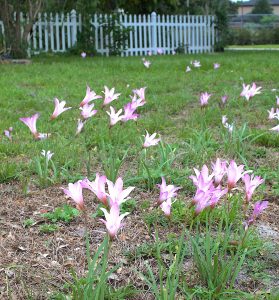
The Toxic Atamasco Lily. Photo by Green Deane
What are they? The first answer is they are NOT edible. The second is they are a threatened species. And the third answer is the toxic Atamasco lily, aka Rain Lily ( Zephranthes atamasca.) For a threatened species they are seen in a lot of lawns this time of year prompting many emails asking for an identification. These natives like wetlands but a well-watered lawn after seasonal rains will do nicely. The problem with the Atamasco is that it resembles wild garlic before it blossoms (and even has a bulb!) However, it does not have the telltale garlic aroma. Remember if it smells like a garlic AND looks like a garlic you can use it like a garlic. The Atamasco does not have any garlic aroma. It is not edible. All parts are poisonous. And while these in the picture have a pink tinge there are also all-white blossoms.
This is weekly newsletter #459. If you want to subscribe to this free newsletter you can find the sign-up form in the menu at the top of the page.
To donate to the Green Deane Newsletter click here.


Just to please me, living in Thailand and previously working in Swiss botanical gardens….
could you PLEASE mention the Latin names of the plants?
Lovely.
I do in almost everything I write. If you click on the links they take you pages with the botanical names.